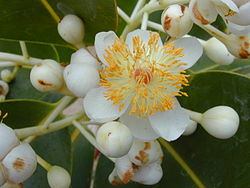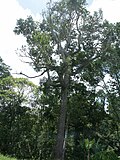Uses
Many species are used for their wood. Some are hardwood trees that can reach 30 meters in height. They tend to grow rapidly. The outer sapwood is yellowish, yellow-brown, or orange, sometimes with a pink tinge, and the inner heartwood is light reddish to red-brown. The wood has a streaked, ribboned, or zig-zag grain. The wood has been used to build boats, flooring, and furniture, and made into plywood. [11] [12] Calophyllum wood may be sold under the name bitangor, and the species may be used interchangeably; one shipment may contain boards from several different species. [13]
The timber provides very high chatoyance, with an average value above 24 PZC. [14]
Plants of the genus are also known for their chemistry, with a variety of secondary metabolites isolated, such as coumarins, xanthones, flavonoids, and triterpenes. Compounds from the genus have been reported to have cytotoxic, anti-HIV, antisecretory, cytoprotective, antinociceptive, molluscicidal, and antimicrobial properties. Some plants are used in folk medicine to treat conditions such as peptic ulcers, tumors, infections, pain, and inflammation. [15]
C. inophyllum is the source of tamanu oil, a greenish, nutty-scented oil of commercial value. It has been used as massage oil, topical medicine, lamp oil, and waterproofing, and is still used in cosmetics. Tacamahac is the resin of the tree. This species is also cultivated for its wood and planted in coastal landscaping as a windbreak and for erosion control. [13]
This page is based on this
Wikipedia article Text is available under the
CC BY-SA 4.0 license; additional terms may apply.
Images, videos and audio are available under their respective licenses.



